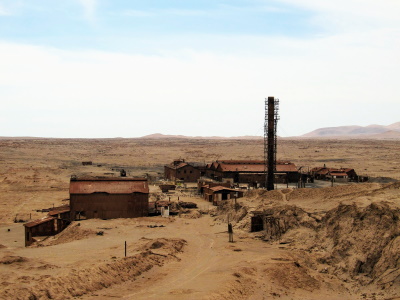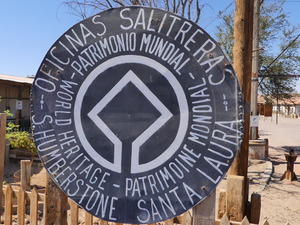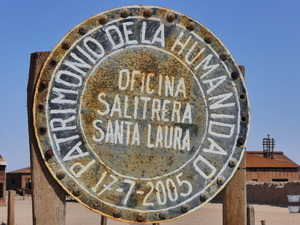Humberstone and Santa Laura Saltpeter Works

The Humberstone and Santa Laura Saltpeter Works represent the technical heritage and the social transformation brought about by the saltpeter industry.
Exploiting the largest deposit of saltpeter in the world, these two industrial sites were in use from 1872 until the mid-20th century to produce nitrate fertilisers for the rest of the Americas and Europe. Thousands of workers lived in company towns in this remote environment and developed a distinctive Pampinos culture.
Community Perspective: Humberstone has the best-preserved town remains, while Santa Laura is the more impressive for its industrial area but is in a bad and potentially dangerous condition. The sites lie only 2 km apart and can easily be visited by local bus from Iquique.
Map of Humberstone and Santa Laura Saltpeter Works
Load mapCommunity Reviews
Els Slots

I did a DIY trip to Humberstone & Santa Laura on public transport in March 2024.
The first usable bus to Humberstone leaves at 8 a.m. (with Pulman Santa Angela in a minivan, 3,000 pesos, pay to the driver). It is approximately an hour's drive to the former saltpeter quarries, which open to visitors at 9 a.m. Along the way, the road crosses spectacular high walls of sand similar to those you see on the Peruvian coast. The bus dropped me off along the highway, from where you can walk to the Humberstone site via a footbridge. Being so early, it all looked a bit spooky and deserted, and I noticed a German shepherd dog watching me from a distance.
Once I entered the gate, I found the guard and the ticket seller sitting already at their posts ready for the day. The entrance costs 6,000 pesos (6 euros) and is valid for both locations: Humberstone and Santa Laura 2km away. Someone must have been very busy beforehand also, as the site of Humberstone consists of dozens of small exhibitions housed in virtually every building still standing. So every day someone has to open and close all the locks on these doors!
When you look at Chile’s WHS it is tempting to compare Humberstone with Sewell as they are both remains from early 20th century mining areas. Their setting is very different though, the mountain landscape within an active mining area at Sewell is much more dramatic. Life for the workers at Humberstone also doesn’t seem to have been as ‘privileged’ as for those in Sewell. Until 1924, workers at Humberstone were for example forced to make their purchases at the company-owned Pulperia (shopping arcade) with tokens they earned instead of money.
As other reviewers have noticed, you will spend a lot of time at Humberstone as there are so many structures open to the public; I lasted 2.5 hours. It’s great to explore and also roam away from the main streets. Highlights for me included the Art Deco-style hotel and the swimming pool made out of (reused) bolted sheets of iron and Douglas Fir (pictured). At the former main square a souvenir shop sells drinks and ice cream, and I sat on a bench there for a while. A small group of tourists had arrived after me as had another couple, so the site seems to attract a steady trickle of visitors.
What then followed was the windy and exposed walk through the desert to Santa Laura. You can see it from far away so you won’t miss it. There’s a footpath but it isn’t much shorter or easier than the road. Only one guard is on supervision here; I met him while I wandered in the rooms of the first 'museum' and he checked my ticket. Santa Laura relies mainly on its industrial remains, the village is in ruins. It makes for good ‘industrial’ pictures but overall is less interesting than Humberstone.
For the return bus to Iquique I had to walk back to the main road where there is a bus stand right next to the Humberstone exit. Within 30 seconds a minibus from Paraiso del Norte stopped and took me back to Iquique city center. I had walked almost 10 km on the grounds of Humberstone and Santa Laura and the road between them.
Having to ‘tick’ Humberstone, you automatically end up in Iquique as well. I found it a pleasant town with great seafood, and it is well worth staying overnight.
Read more from Els Slots here.
Clyde

I visited both components of this WHS in 2023 by rental car from Arica. It is a long drive in the Atacama desert in Northern Chile which I'll gladly revisit next time using Antofagasta or San Pedro de Atacama as my base (even if it might not include anything WH related).
I started with the larger and main component of this WHS, Humberstone Saltpeter Works. There is a handmade WHS plaque in each of the two components as well as a more formal/official one at both. Combined tickets can be bought at any one of the two components and there is enough space to park in front of both sites. Although both components are very close to each other by car (small unpaved road towards the last stretch to Santa Laura), a long walk between them is better avoided as it is a very dusty trail with no shade whatsoever. If you don't have a rental car, I would suggest hitching a ride from any other tourists visiting Humberstone. It's true that you can spend a full day to thoroughly visit both components, but if you read up and do your research online on the highlights you wouldn't like to miss, a packed and moderately active half day could be enough to try to grasp the site's OUV, or at least whatever is left of it.
Humberstone and Santa Laura Saltpeter Works are testament to the historical importance of saltpeter mining in Chile and the culture and social agenda that developed around it in the late 19th century. Other non-inscribed "nitrate" towns related to saltpeter mining in the area are Chacabuco, Maria Elena, Pedro de Valdivia, Puelma and Aguas Santas. Both Humberstone and Santa Laura Saltpeter Works nowadays look like abandoned ghost towns and although their derelict buildings have been removed from the list of WHS in Danger in 2019, I really can't imagine how these components could have been worse off.
In Humberstone, the area to cover is much larger and there is much more left to see here than in Santa Laura. Humberstone includes a residential area with a church, a theatre, a school, a grocer, a cooling chamber, living quarters, guest houses, a swimming pool (later reused in the industrial process). Although there are a number of signs and information boards in English and in Spanish, I recommend taking a photo of the map drawn near the Humberstone entrance ticket booth to be able to locate the area where you might have possibly missed visiting. Even though the residential area has been recently restored, there are still some buildings which have collapsed or need restoration works again. The more industrial area of Humberstone is much more derelict and the main elements here are rusty machinery, rusty industrial tools, rusty railways, locomotives and wagons, rusty structures, and more rust, rust and rust. The wind reigns supreme here and is constantly leaving its heavy toll on any remaining saltpeter mining structures. I enjoyed following and learning about the industrial process first hand from the remains here. In the industrial area, there are signs that you enter what's left of the structures at your own risk and rightly so, as every day the security guards at site, patrol the area before opening and closing the sites, to clear some new area which has crumbled or been blown off by the wind. You also have to watch your step wherever you walk as there are sharp rusty remains, barbed wire, nails, etc. everywhere making it quite easy to injure yourself if you're not extra careful.
The Santa Laura Saltpeter Works is much smaller and the industrial giant has recently lost a number of its "iconic" components which might be restored/reconstructed in the near future, namely one of the tall chimneys which was being secured during my visit, and the conveyer belt which has collapsed and broken down in 2 separate parts. Make sure to bring good sturdy shoes, water and a cap here as you're literally roaming in the desert heat, which is exacerbated by the constant winds.
Overall, this industrial WHS deserves its place on the WH list, but it is also a very good example of how several industrial WHS inscribed on the list risk disappearing due to the passage of time and their harsh natural environments. They aurely won't be around for as long as the Roman, Egyptian or Medieval WHS, but perhaps that might be a good thing after all!
Timonator

Buses leave from opposite Mercado Centenario in Iquique, cost 3.000 Pesos and take 1 hour to Humberstone. Beautiful to see they leave on certain times independant of the amount of passengers after having lost some hours of my life for waiting for trufis to be full in La Paz for going to Tiwuanaku. You get thrown out on the wrong side of the highway but there is a pedestrian bridge over the big street and after 10 minutes more there is the entrance to Humberstone where the tickets for both sites- Humberstone and Santa Laura- are obtained. Currently they cost 6.000 pesos p.P.. There are tours offered in Iquique for 35.000 pesos half day Humberstone & Santa Laura and full day Humberstone & Santa Laura and some desert oasises like Pica further away. I would definetely NOT recommand these, as they're much more expensive for transport, guide and some food and they tear the focus from this WHS away. 3 hours is NOT sufficient to see and digest the Humberstone and Santa Laura sites. We have spent 5,5 hours in Humberstone and 1 hour in Santa Laura and have rushed a little bit. You can easily spend the full day here from 9 a.m. to 6 p.m. if you want to read through all the information which you will find mainly in Humberstone. Between the two sites it's a 25 minute walk on a signed pathway. You will have to walk back for cathing the bus to Iquique from the opposite side of the highway. Luckily some Chilean visitors on the parking took us back for free after asking them.
I find the site quite comparable to the Sewell Mining Town from the experience. It's also an abandoned, industrial site with a ghost town where workers had lived which is situated in Chile. This site is about the nitrate production from the caliche which is found here and once was the basis for 90% of the saltpetre used in the world mainly for fertilizers. After the discovery of a synthetic way to produce fertilizers the production out of the caliche became inefficient probably because of transportation matters as one of the reasons and caused the closure of the sites Humberstone and Santa Laura in 1960. Afterwards the sites became a national monument and later WHS. The museum in Humberstone is one of the better museums in Latin America. Some rooms have too many information and some only display artifacts without further information but there are good English translations available and a lot of visible displays to discover. I liked the exhibition in the Pulperia (grocery store) the most. The Urban sector of Humberstone appears like a Western Town during Siesta underlined by a very small amount of other visitors. There is a lot to discover and I would recommand to take a picture from the numbered map at the entrance to not get lost or miss anything. The industrial part I found a bit spooky. You're alone between rusty and huge remains of the factory which make sounds in the wind and appear like thed could collapse anytime soon. Some explaination signs tell you how the process went from Caliche to crystalized salpetre however I found it hard to connect it to the remains I have seen. The mirador gives a nice overview of the organised pattern of the urban part.
Santa Laura appears similar to the industrial part of Humberstone
The urban part is mainly ruins. The part in which the caliche gets mixed and heated with the liquids to extract the salpetre is huge and can be seen from many kilometres distance. Again I find it a bit spooky running around here alone as with the partially heavy wind in the desert the buildings seem to talk to you. The only real danger though would be falling parts of the construction or falling or tripping on the floor full of industrial remains though.
I can really recommand visiting the sites as they have been histotically very relevant roughly a hundred years ago and give a good impression of what was going on here. Today they contain a good museum and are still an impressive appearance in the desert.
Read more from Timonator here.
Zoë Sheng
Chinese-Canadian - 16-Nov-19 -

2019 Removed from Danger list
whaaaaaaat?
So basically this place is crumbling to pieces and I see no maintenance done at all. In fact each building I stepped close to I was almost afraid it was going to collapse, but then I'm adventurous so I actually walked across beams and into the back of buildings to find ghosts - oh wait I mean, cool dusty machinery that used to be part of this great site, and I mean "great" as in a large. It's huuuuge. It takes hours to see everything. The best creepy pictures were when the sun started to set. I kind of felt like this was the Nostromo after the Alien took out all the crew members and it drifted in space for a while. It was also that deserted but the season probably causes little guests to come out here in windy weather.
Alright so this place used to be a massive saltpeter work, with workshops, housing, trains, clinic. It was probably awesome to see in its heyday. Strolling down the dusty road at the entrance that reminds you of a wild west town at the other side of the continent. I am imaging it all glorious but the presentation now is more for photoshooting: creepy haunted houses have nothing compared to this place. The guys from these stupid ghost hunting shows should check it out or maybe the Conjuring couple.
I suggest you check this out before it gets closed for being too dangerous. Once the factories in the back have collapse you are missing the best part of the show.
Ammon Watkins
Visited dec 2018. Humberstone is a little out of the way in the north of Chile but I love these kind of sites so we suffered the extra 6 hours on a bus from San Pedro de Atacama to get to Iquique. Fortunately domestic flights are cheap in Chile (for now) so could fly back to Santiago easily after.
The site is easily visited by local bus from Iquique, dropping you off on the main highway out front. Humberstone and Santa Laura are easily visible from there. As the representative of over 200 similar sites in the region I can only imagine the poor state the others must be in. Parts of Humberstone (the plaza, theatre, market a few homes, etc) have been restored and the museums are full of quality detailed information, but what I liked the most was wandering through the rusted fences and into the broken homes and factories still barely standing. Without more support most structures might not last much longer as is the worry with Santa Laura. Unfortunately we spent so long in Humberstone that we didn't have time to walk the 2km over to Santa Laura and see it as well. I'd suggest an early start to be on the safe side.
Hard to believe that not so long ago this region at its peak was producing nearly 90% of the world's nitrates and now it is nearly forgotten, wearing away in the desert. Overall a very worthy inclusion of a globally significant site.
Chris
I visited the site end of 2014. Humberstone is in pretty good shape but Santa Laura I can imagine it's on the danger list. The sites really show the history of the mining. When I visited there were not that many visitors in Humberstone and in santa Laura I was the third that day only. It's a ghost town, and when you just stand still you only here the howling wind through the buildings.
Read more from Chris here.
Jarek Pokrzywnicki
Visited the site in November 2006. Sunny and hot day so you could imagine how it is to wander throughout a desert whe the whole salitera is located. Site consist of 2 units: Humberstone ghost town with market square, church, theatre, swimming pool school and numer of houses (all restored) and Santa Laura factory (much more ruined, that's why it is listed on List in Danger) located some 2 km from the town) and numerous other object (railways, dumps, paths, ruins). Recommended for those who like factory architecture or want to see the life of workers in Chile some 50-100 years ago. But hurry up - the desert and winds deteriorate the condition of the site constantly.
Community Rating
Site Info
Site History
2019 Removed from Danger list
2005 In Danger
"Extremely fragile nature of the buildings; Lack of maintenance for 40 years; Vandalism due to looting of re-usable materials; Damage caused by the wind"
2005 Inscribed
Site Links
Unesco Website
Official Website
Related
In the News
Connections
The site has 20 connections
Art and Architecture
Constructions
Damaged
Ecology
Geography
Human Activity
Timeline
Trivia
WHS Names
WHS on Other Lists
World Heritage Process
Visitors
59 Community Members have visited.
The Plaque
 (photo by Clyde)
(photo by Clyde) (photo by Clyde)
(photo by Clyde)